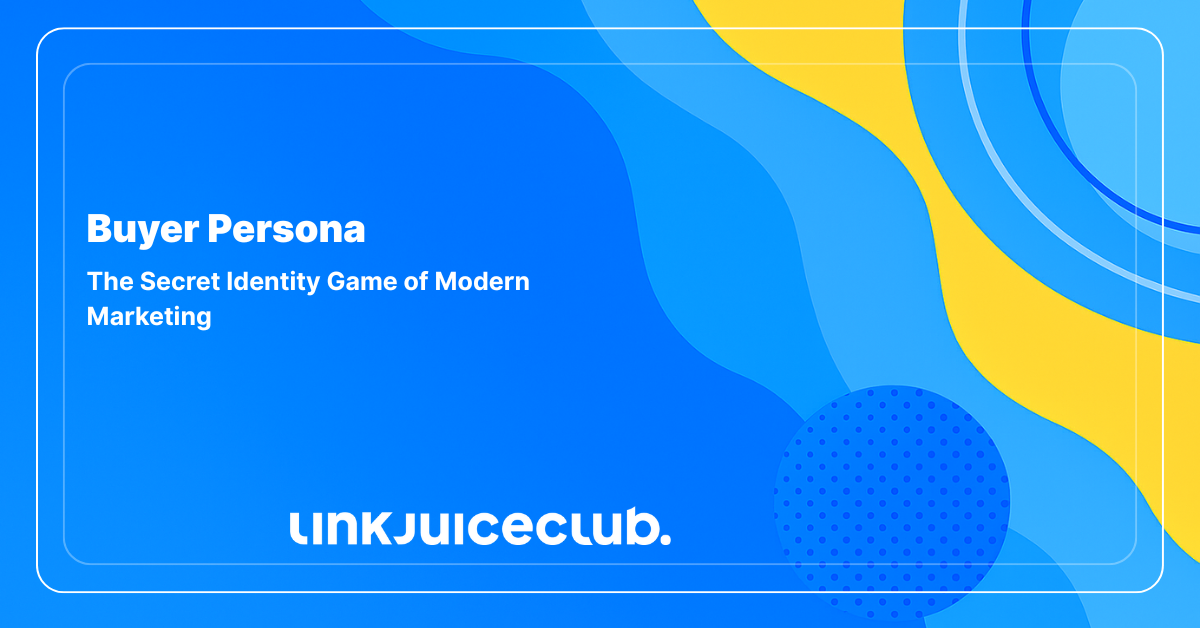
Buyer Persona: The Secret Identity Game of Modern Marketing
Modern marketing isn’t about casting a net and hoping for a catch. It’s actually about crafting a message that speaks so precisely, your reader feels like you’re reading their mind.
That magic trick is called building a buyer persona… And no, it’s not just a glorified customer profile with a cute name and a vague bio.
Whether you’re selling yoga mats, cloud software, or artisanal pickles, your messaging should land like a well-aimed dart. And that means thinking beyond demographics.
A good buyer persona is about knowing what your buyers want, what they fear, how they make decisions, etc.

What Even Is a Buyer Persona, Anyway?
A buyer persona is a fictional, but deeply informed, profile of your ideal customer. Think of it as a composite sketch built from real data, research, and behavioral insight.
These personas go beyond name and job title. You’re mapping out goals, frustrations, decision-making habits, preferred communication channels, and even what kind of messaging tone they’ll actually respond to (spoiler alert: nobody wants corporate-speak).
Most businesses don’t just have one buyer persona. You’ll likely need a few to represent different segments of your audience, like the first-time buyer vs. the power user, or the budget-conscious shopper vs. the premium loyalist. And once you’ve built them, they become your internal compass for everything from product design to copywriting to sales enablement.
But What’s a Negative Buyer Persona?
Not every lead is a good lead. Sometimes, knowing who you don’t want to attract is just as powerful as knowing who you do. That’s where a negative buyer persona steps in.
While traditional buyer personas help you craft messaging for your dream customers, negative personas are the ones that wave a little red flag and say: This person? Probably not worth the spend.
Here’s how it works: let’s say you’re running a tech bootcamp that focuses on helping mid-career professionals learn about UX design. You want learners who are committed, have basic digital literacy, and are serious about job placement. But then there’s Casual Cody.
Cody is a 19-year-old gaming enthusiast who saw one TikTok about making $150k in tech and signed up out of curiosity. He’s not ready to commit, he’s not your target age group, and he’s likely to drop off after two modules. Cody’s not a bad person; he’s just not a good fit.
Creating a negative buyer persona like Casual Cody helps your team avoid wasted ad spend, prevent customer churn, and keep your content laser-focused on high-value prospects.
So yes, say yes to your dream customers. But also, don’t be afraid to lovingly ghost the ones who just aren’t your people! 👻
Buyer Personas Are Your Secret Weapon
Without a clear picture of who you’re talking to, your marketing becomes a polite shout into the void. Buyer personas aren’t some academic exercise. They’re the filter through which your brand gets personal, relevant, and actually useful.
It Puts the Customer at the Center of the Plot
You are not the hero of your own story, your customer is. The minute your brand stops bragging about how shiny it is and starts focusing on how it helps them, everything shifts.
Buyer personas keep you customer-obsessed (not brand-obsessed), and that’s where the magic happens. Instead of how do we sell more of our app? the conversation becomes how do we make Hannah’s day easier with this app?
It Makes Your Copy Feel Like a DM, Not a Billboard
When you write with a buyer persona in mind, your messaging gets laser-focused. Suddenly, you’re not addressing an audience. The best copy feels like it knows the reader’s vibe. Buyer personas help you drop the you all and start using the kind of language that hits one person, in the right moment, with the right tone.
Buyer Personas Make Content Actually Make Sense
Let’s not pretend everyone wants the same thing. A buyer persona connects the dots between your product and the actual human using it.
It’s not just about who your customer is; it’s about why they care. Without this link, you’re basically shouting into the void.
Buyer Personas Get Everyone Speaking the Same Language
Have you ever been in one of those meetings where marketing’s excessively using acronyms, sales is speaking in code, and customer support looks like they need a coffee and a lifeline? Yep, total chaos. That’s what happens when no one agrees on who they’re actually trying to reach.
The buyer persona comes in handy in this respect. Think of it as your team’s shared map. When everyone’s working from the same character, things click. Marketing stops guessing. Sales knows exactly how to pitch. Support knows what problems they’re likely to face.
Suddenly, everyone’s rowing in the same direction and the boat stops spinning in circles.
Personalization That Doesn’t Feel Creepy (Just Smart)
Most personalization in digital ads is like getting a birthday card from your dentist. But when you craft content with a detailed buyer persona in mind, personalization becomes relevant, not random.
It’s all about tapping into real motivations, behaviors, and needs. When you know exactly who you’re talking to, your content resonates, connects, and converts.
Budget-Friendly Brilliance Starts With a Buyer Persona
When you know who you’re talking to, you stop wasting time yelling into the void. Buyer personas streamline your entire approach, no more guesswork, no more scattershot spending.
Campaigns become laser-focused. Emails get clicked. Landing pages actually land. Ads? They finally reach the right people. Every cent you spend is sharper, smarter, and significantly more effective.
Loyalty That Goes Beyond the Cart
When your content feels like it gets your audience, they stick around. And not just for one purchase.
The brands that inspire devotion (like LEGO) aren’t lucky. They’re intentional. They obsess over who their audience is and create experiences that feel personal, playful, and unforgettable.
Building Buyer Personas That Don’t Suck
A buyer persona is a living, breathing guide to the humans behind the clicks. If you want yours to actually do something (like fuel better marketing, boost conversions, and get your team aligned), you need more than a hunch and a pretty name.
Dig Into Real Data
Your customers are talking, you just need to listen. Website analytics, support tickets, user surveys, reviews, and even DMs are full of insights.
Don’t rely on guesswork or team assumptions. Real buyer personas are rooted in patterns, not opinions. The more you ground them in actual behavior, the more useful they’ll be across campaigns.
Focus on Goals, Fears, and Frustrations
Forget fluffy descriptors. Get inside your audience’s head. What keeps them up at night? What are they chasing? Understanding their motivations and anxieties helps you craft messaging that speaks directly to what they care about, not what you wish they did.
Keep Them Fresh (No One Likes a Stale Persona)
The internet changes fast. So do your customers. What worked last quarter might be irrelevant today. Revisit your personas regularly, update them with new data, and let them grow with your audience.
Your Brand’s Built-In Filter
Marketing without buyer personas is like throwing spaghetti at a wall and hoping one noodle spells ROI. When you know exactly who you’re talking to, everything sharpens: your voice, your value, your results. Personas slice through the fluff, helping you ditch generic content and create stuff that actually lands.
In a world full of noise, the brands that win are the ones who know exactly who they’re talking to, and talk like they mean it.





